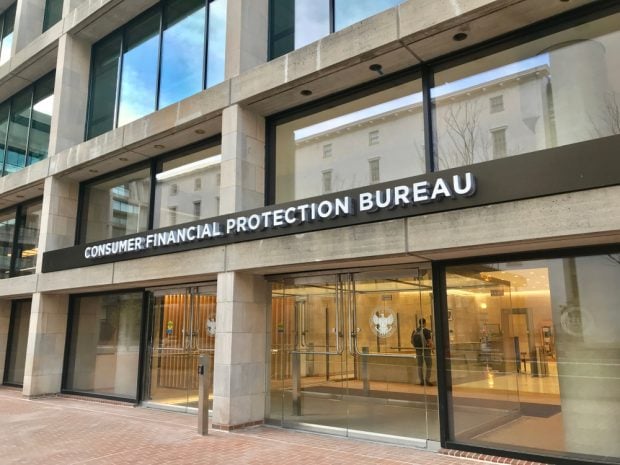 CFPB headquarters in Washington, D.C. (Source: Shutterstock)
CFPB headquarters in Washington, D.C. (Source: Shutterstock)
A bill being marked up by the House Wednesday is called the "CFPB Transparency and Accountability Reform Act," but it reminds the head of the Center for Responsible Lending of the attempt in 2017 to shut down the bureau.
The CFPB was created in 2010 to enforce provisions of the Dodd-Frank Act, which Congress passed to prevent abuses that contributed to the financial meltdown in 2007 that led to the Great Recession.
Recommended For You
After Donald Trump became president in 2017, he appointed Mick Mulvaney as director of the Office of Management and Budget. After Mulvaney became interim director of the CFPB, he has said he tried to shut it down by shutting off most funding.
Mike Calhoun, president of the Center for Responsible Lending based in Durham, N.C., said in an interview with CU Times Tuesday the main weapon of CFPB opponents has been to try to place the CFPB under direct congressional appropriations. An annual appropriation would subject the agency to riders that could restrict or prohibit enforcement of rules to the extent it no longer functions.
CUNA has long supported placing the CFPB under the traditional appropriations process. NAFCU has long held that credit unions should be exempt from CFPB jurisdiction and instead be regulated solely by the NCUA.
The bill introduced Monday by U.S. Rep. Andy Barr (R-Ky.) would "bring the bureau under the regular appropriations process."
It would also:
- Change the leadership structure from a single director to a "bipartisan, five-member commission."
- Create a dedicated Inspector General for the bureau "to ensure transparency, accountability and to prevent waste, fraud and abuse."
- Create a new Office of Economic Analysis and require cost-benefit analysis for all guidance, orders, rules or regulations of the bureau.
- Require all proposed rules to consider the impact on small businesses.
- Provide awards to whistleblowers who report original information relating to a violation of consumer financial law resulting in certain monetary sanctions exceeding $1 million.
Meanwhile, the U.S. Supreme Court announced Feb. 27 it will consider a case that might decide if the CFPB's independent status is constitutional. If the court decides against the agency, it could force it to come under direct appropriations.
The Supreme Court expects to hear oral arguments in October, with a ruling possible in the spring of 2024.
And the court's decision could have ramifications that could extend well past the CFPB. If the Supreme Court strikes down the existing funding mechanism, the FDIC, NCUA and other agencies set up to be shielded from congressional whims might also be subject to annual appropriations.
"That is one of the major risks of this court action," Calhoun said. "This would be a radical restructuring of government that would be harmful."
 Mike Calhoun
Mike Calhoun CUNA and NAFCU have been frequent critics of the CFPB. In opposing recent rules to require larger lenders to report business loan data, NAFCU accused the CFPB of "waging a war on Main Street."
The Center for Responsible Lending is the policy arm of Self-Help, a community development lending group that houses both Self-Help Federal Credit Union ($2.1 billion in assets, 100,699 members as of Dec. 31) and Self-Help Credit Union ($1.8 billion in assets, 90,577 members).
Calhoun said many comments from the credit union trade groups represent "natural friction" with regulators. The groups have advocated for cutouts to shield smaller institutions from the more rigorous standards, and the CFPB has made many such accommodations, he said.
However, Calhoun said the legislation introduced in the House is not about reform.
"The agenda of many behind this effort is to kill the CFPB, not to adjust how it operates. I would hope credit unions would not lend their voices to that effort," he said.
Calhoun cited a poll commissioned by the Center for Responsible Lending and Americans for Financial Reform and released last December that found:
- 79% of voters said they favored the agency with strong majorities across party lines, after hearing a brief description of the CFPB and its mission.
- 72% supported the CFPB cracking down on discrimination in all areas of consumer financial products, not only in lending.
- More than 70% supported proposals to rein in harassment by debt collectors, protect student borrowers from abuse, limit credit card and overdraft fees, lower the interest rate on high-cost loans to 36% and stop financial technology companies ("fintechs") from evading consumer protections.
"It shows extraordinarily high, bipartisan support for the CFPB," he said. "The general public likes what the CFPB is doing."
© Touchpoint Markets, All Rights Reserved. Request academic re-use from www.copyright.com. All other uses, submit a request to [email protected]. For more inforrmation visit Asset & Logo Licensing.







